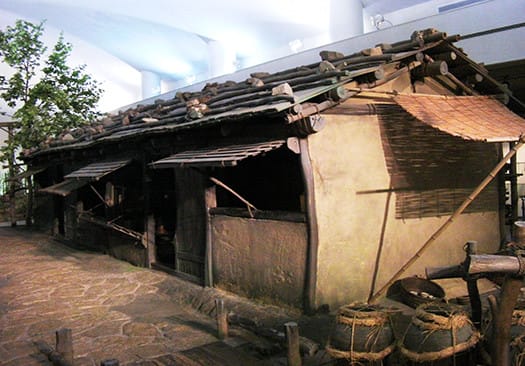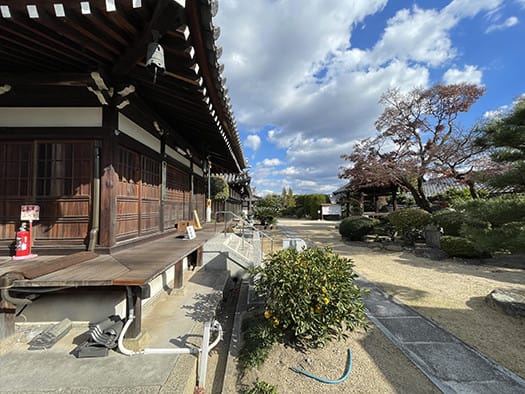


きのうの続きです。わが家の家系はこの福山市西部の今津町で確実に商家として生業を営んでいたようなのですが、そういう「営業実態」についての記録や実物などは、北海道移住に際しての混乱期に多くが散逸していて、なかなか確認することができませんでした。たまたまわたしはこういう「探究・深掘り」が住宅(関連)取材として興味と機会があるので、企図してきていた。しかしなかなかリアリティと整合性のある「実感」には至っていなかったのです。
そういうもどかしさを抱えながらいたのですが、草戸千軒遺跡の取材と、わが家が強く関係していた今津の蓮華寺の様子、それらが同一生活文化圏、宗教文化圏としてもきわめて近接し相互に関係している状況事実とクロスすることで、生々しく浮かび上がってきた次第です。
わが家は瀬戸内海地域有数の「商都」であった尾道を本拠とする商業ビジネス集団「あがや」に属していたことは確実なのです。わたし自身も遺品のひとつとして商家としての「あがや」家紋入りの「膳部」を承継保有しています(笑)。江戸期の「商家」の営業実態としては、物流としての水運利用によって、物資の流入する尾道のような港湾商業都市拠点から、販売先地域への物流の継続的運営管理が生命線なのでしょう。草戸千軒遺跡は江戸期には衰退していたとされていますが、瀬戸内海と河川(芦田川)の水運を利用していたことは発掘などから明白な事実。その水運機能が草戸では衰退していたのに対して「今津」<イマドキの港という含意>の地名自体でわかるように、中世期の草戸千軒と同様の水運物流機能が、この今津で確保されていたのでしょう。
そしてその物流の対象先は、「今津宿」とされた参勤交代の宿場機能に対してだった。この今津には薩摩藩や平戸藩などの西国大名家が「定宿」として利用してきた事実がある。「本陣」としての「河本家」と「脇本陣」としての「蓮華寺」への物資納品の役割を独占していた事実。まさに大名家などが必要とする物資を尾道の「あがや」本拠から調達して流通販売することが、主要な江戸期の経済物流機能だった。その物流のリアリティが草戸千軒遺跡の発掘痕跡ジオラマと、まったく同一文化圏だった事実から、まさになまなましく実感できたのです。
言ってみれば、中世の草戸千軒の役割が、江戸期のこの今津で再生されていたのでしょう。
わが家の家系伝承では、平戸藩主の松浦静山の書き記した「甲子夜話」に今津宿本陣での大名貴賓接遇に一家を挙げて奉仕している様子が記録されている。
そうした商家としての営業の基本構造が見事に「見える化」されてきた次第。う〜むオモシロい気付きが得られたと頓悟しております。全体イメージを知る大きな機縁。
English version⬇
[Actual business conditions of ‘local small and medium-sized merchant families’ in the Bingo Fukuyama Domain during the Edo period].
The reality of the business conditions of our family's ancestors has become visible. The breath of life has been intensely felt. ...
This is a continuation of yesterday's article. My family seems to have been a merchant family in Imazu-cho in the western part of Fukuyama City, but many records and actual objects relating to the ‘business situation’ were scattered during the period of confusion when the family moved to Hokkaido, so it has been difficult to confirm the existence of such a family. It just so happened that I had planned to do this kind of ‘exploration and in-depth research’ as a housing (related) journalist because I was interested and had the opportunity to do so. However, I have not been able to come to a ‘real feeling’ of reality and consistency.
I had been feeling frustrated about this, but by crossing the coverage of the Kusado-Senken site with the situation at Renge-ji Temple in Imazu, to which my family was strongly related, and the fact that they were very close and interrelated as the same living and religious cultural sphere, the situation came to the fore in a vivid way.
It is certain that my family belonged to the Agaya, a commercial business group based in Onomichi, which was one of the leading ‘commercial capitals’ of the Seto Inland Sea region. I myself have inherited a ‘zenbu’ with the ‘Agaya’ family crest as a merchant family as one of my personal belongings (laughs). The business reality of a merchant family in the Edo period was the continuous operation and management of logistics from port commercial centres such as Onomichi, where goods flowed in through the use of water transport as logistics, to the areas where the goods were sold. Although the Kusado Senken site is said to have declined during the Edo period, it is an obvious fact from excavations and other evidence that the site made use of water transport from the Seto Inland Sea and rivers (Ashida River). While the water transportation function was in decline at Kusado, the name of the place itself, ‘Imazu’ (meaning ‘Imadoki port’), indicates that the same water transportation and distribution function as at Kusado-Senken in the medieval period was secured at Imazu.
The logistics destination was for the function of an inn for the pilgrimage, which was called ‘Imadzu-juku’. It is a fact that this Imazu has been used as a ‘fixed inn’ by the Satsuma and Hirado clans and other western daimyo families. The Kawamoto family monopolised the role of delivering goods to the Rengeji Temple, which served as the ‘main lodge’ and the ‘side lodge’. The main economic and logistical function of the Edo period was to procure the goods needed by the feudal lords and others from the ‘Agaya’ headquarters in Onomichi for distribution and sale. The reality of this logistics could be seen in the diorama of excavated traces at the Kusado-Senken site and the fact that they were in exactly the same cultural sphere, which made it possible to feel the reality of the logistics in a very sedate way.
In other words, the role of Kusado-Senken in the Middle Ages was being recreated here in Imazu during the Edo period.
In our family tradition, the Koshi Yawa, written by Shizan Matsuura, lord of the Hirado domain, records how the whole family served at the Imazu-juku Honjin for the reception of noble guests of feudal lords.
The basic business structure of such a merchant family has been successfully ‘visualised’. I am now realising that I have gained some interesting insights. A great opportunity to understand the whole picture.




























※コメント投稿者のブログIDはブログ作成者のみに通知されます